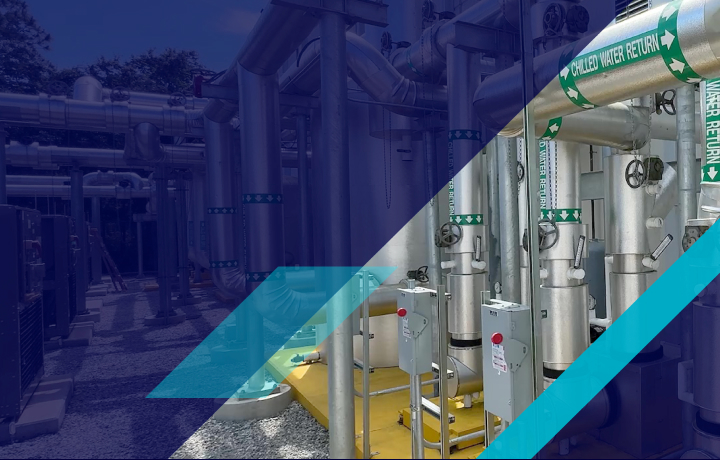Energy efficient data centers: Best practices & innovations
Energy-efficient data centers are built to do more with less, delivering top performance while minimizing energy use and environmental impact. The difference between an efficient facility and an inefficient one can mean millions in annual energy costs and a dramatically different carbon footprint.

For IT leaders evaluating colocation providers or planning infrastructure, understanding what drives efficiency helps you make decisions that support both your budget and sustainability goals. It’s about looking beyond marketing claims to see how cooling systems, power distribution, and design choices directly affect your bottom line.
Why energy efficiency matters in data centers
The growing demand for data centers
Global electricity demand from data centers could double by 2030, driven largely by AI and expanding digital infrastructure, according to the International Energy Agency. High-density computing that once seemed specialized is now standard, as GPU-intensive workloads move from research labs into everyday production systems.
That surge comes with big implications. Each new rack of servers produces heat that must be managed around the clock and requires redundant power systems to ensure uptime. Some modern AI deployments exceed 80 kilowatts per cabinet, pushing cooling and electrical systems to their limits.
Importance of energy efficiency
Energy costs make up roughly 60% or more of a data center’s lifetime operating expenses. When a facility runs inefficiently, every watt wasted drives costs higher. The environmental impact matters, too. While the industry’s share of global CO₂ emissions has dropped from 2% to 0.3%, total energy use keeps rising.
Efficiency also affects reliability. Overheated equipment fails more often and wears out faster. The same practices that reduce waste, like optimized airflow and advanced cooling, extend equipment life and improve uptime.
Understanding data center energy consumption patterns helps you identify where improvements will have the greatest impact.
Key components of an energy-efficient data center
Energy-efficient hardware
Hardware choices set the foundation for efficiency. Modern servers and switches deliver far more compute per watt than older models, but only if they’re used effectively.
Low server utilization is a silent energy drain, as a server running at 20% capacity still consumes most of its full-load power. Virtualization and containerization consolidate workloads onto fewer machines, keeping utilization high and waste low.
Refreshing aging hardware also pays off. A five-year-old server can use twice the power of a new one while delivering half the performance.
Advanced cooling technologies
Cooling is often the largest energy consumer outside of IT equipment, making it a prime target for efficiency gains.
- Hot and cold aisle containment keeps hot exhaust air from mixing with cool supply air, cutting cooling energy use by 20% or more.
- Direct-to-chip liquid cooling circulates coolant directly to processors, supporting rack densities above 80 kW while using less energy than traditional air systems.
- Immersion cooling submerges servers in a thermally conductive, electrically safe liquid, ideal for AI and high-performance computing.
- Free cooling takes advantage of cool outside air or water, minimizing reliance on mechanical chillers. In some climates, facilities can run chillers less than 1,000 hours a year.
For high-density colocation, these liquid cooling data center strategies deliver better heat management and lower overall energy use.
Power management systems
Efficient power delivery begins at the utility feed and extends to every rack. Electrical components rated at 97% efficiency or better help reduce waste heat and energy loss.
Uninterruptible Power Supply (UPS) systems protect against outages, but efficiency drops at low loads. Modern configurations balance redundancy and efficiency to keep performance high without compromising reliability.
Intelligent power monitoring adds another layer of control, tracking usage from the facility level down to individual circuits, revealing where loads can be balanced or equipment upgraded.
Design strategies for reducing energy consumption
Architectural design features
Energy efficiency starts before a single server is installed, as the physical layout of a facility determines how much energy it will use over time.
Raised floors with deeper plenums (36 inches or more) improve airflow distribution in underfloor cooling systems. Equipment placement matters too: distributing high-density racks evenly prevents hot spots that demand extra cooling.
Modular construction offers flexibility and efficiency, allowing facilities to scale power and cooling capacity as demand grows rather than conditioning unused space.
Following data center best practices during the design phase prevents expensive retrofits and keeps performance high throughout a facility’s life.
Location and climate considerations
Geography plays a powerful role in energy efficiency. Cooler climates allow more use of free cooling, reducing mechanical load. Operators in northern regions often rely on chillers for fewer than 1,000 hours per year.
Local power grids also matter. Access to renewable energy reduces carbon intensity, while regions reliant on fossil fuels increase a facility’s footprint.
Water availability is another critical factor. Traditional cooling towers can consume vast amounts of water through evaporation. Many modern facilities now adopt water-free cooling systems or are located in areas with reliable water resources to reduce environmental strain.
Innovations in data center energy efficiency
Renewable energy integration
Data centers are increasingly sourcing electricity from wind, solar, and other renewable sources to reduce their carbon footprint while maintaining operational efficiency. Renewable energy prices have dropped dramatically over the past decade, making clean power not just an environmental choice but often a financially sound one.
Power purchase agreements provide a scalable path to renewable energy. Through these contracts, data center operators commit to buying electricity from specific wind or solar farms, often at fixed long-term rates that provide budget certainty while supporting renewable infrastructure development.
Waste heat recovery transforms what was once an environmental problem into a resource. Some facilities capture exhaust heat and redirect it to warm nearby buildings, greenhouses, or district heating systems.
AI and machine learning for energy management
AI is transforming how facilities manage energy. Thousands of sensors generate real-time data on temperature, humidity, power, and airflow, far too much for humans to process alone.
Machine learning algorithms analyze that data to predict cooling needs, fine-tune setpoints, and maintain ideal operating conditions with minimal energy use. These systems continuously optimize Power Usage Effectiveness (PUE), keeping it low even as workloads fluctuate.
Virtualization and cloud solutions
Virtualization fundamentally changed how organizations consume computing resources by allowing multiple virtual machines to run on a single physical server. A company that once operated 100 physical servers at 15% average utilization might consolidate those workloads onto 20 physical servers running at 75% utilization, dramatically reducing energy consumption while maintaining the same computing capacity.
Hybrid cloud strategies allow organizations to place workloads in the most appropriate environment based on performance, compliance, and efficiency requirements. Steady-state workloads might run in highly optimized cloud environments while specialized applications requiring specific hardware configurations remain in high-density colocation for power-dense IT environments.
Regulatory and compliance considerations
Global standards and guidelines
Data center operators face an increasingly complex web of regulations addressing energy consumption and environmental impact. The European Union has implemented some of the strictest efficiency requirements through its Energy Efficiency Directive, while California's Title 24 building energy efficiency standards include specific provisions for data centers, setting minimum requirements for cooling efficiency, lighting controls, and power distribution.
Industry organizations have developed voluntary frameworks that often become de facto standards. The Green Grid's metrics, including Power Usage Effectiveness, have been widely adopted as benchmarks for measuring and comparing facility efficiency.
Meeting data center compliance standards requires ongoing measurement, reporting, and improvement efforts that extend beyond initial facility design.
Environmental impact and carbon footprint reduction
Carbon emissions from data center operations have become a focal point for corporate sustainability initiatives and investor scrutiny. Scope 2 emissions from purchased electricity comprise the vast majority of most data center carbon footprints, and reducing these emissions requires either improving energy efficiency to consume less electricity or shifting to cleaner power sources.
Carbon Usage Effectiveness measures total carbon emissions caused by data center energy consumption, providing a more complete picture than PUE alone. A facility with excellent PUE but powered entirely by coal-fired electricity may have a worse carbon footprint than a less efficient facility running on renewable energy.
The path forward for sustainable data centers
Modern energy-efficient data centers prove that sustainability and performance can work together. Facilities achieving PUE ratings of 1.4 or lower show how advanced cooling, intelligent power management, and thoughtful design translate into lower costs and higher reliability.
Efficiency investments consistently deliver long-term returns. High-performance cooling systems and premium electrical components may demand higher upfront costs, but those expenses are typically offset within a few years through substantial energy savings. Evaluating the total cost of ownership, rather than focusing solely on initial capital, reveals the true value of efficiency.
At the same time, rapid advances in technology continue to push efficiency even further. Liquid cooling, once considered niche, is now mainstream, while AI-driven optimization tools enable real-time performance tuning. Together, these capabilities are setting a new benchmark for energy-efficient data centers.
Choosing the right infrastructure partner
At Flexential, efficiency is built into everything we do. Our Generation 5 data centers target a PUE of 1.4 or lower with zero water usage for cooling and support liquid cooling for high-density AI workloads.
We’re continually upgrading existing facilities, cutting energy use by more than 3 million kWh annually through heat exchangers and adiabatic pre-coolers. These improvements reduce operational costs for our customers while supporting their sustainability goals.
Ready to explore how efficient infrastructure can support your business goals? Contact our team to discuss your requirements, or explore our colocation solutions and data center locations to find the right fit for your workloads.
FAQs
What is PUE, and why is it critical for energy-efficient data centers?
Power Usage Effectiveness (PUE) measures how efficiently a data center uses energy. It’s the ratio of total facility power to IT power. A lower PUE means less energy wasted on cooling and overhead.
How do liquid cooling systems compare with air cooling for efficiency?
Liquid cooling moves heat more efficiently than air. It supports higher rack densities and lowers fan energy use, though it costs more upfront and requires specialized systems.
Can waste heat from a data center be reused, and how?
Yes. Some facilities capture exhaust heat to warm nearby buildings or power district heating. Others use it to run absorption chillers, creating a closed-loop cooling system.
What role do AI and machine learning play in optimizing energy use in data centers?
AI systems analyze thousands of sensor data points in real-time to optimize cooling, workload placement, and power distribution. Predictive algorithms anticipate cooling needs before temperatures rise, preventing energy waste from over-cooling. Machine learning can also detect subtle equipment performance changes that indicate developing problems, enabling predictive maintenance that prevents efficiency degradation.
What are realistic efficiency targets for modern data centers?
Modern purpose-built facilities should target a PUE of 1.5 or better, with leading-edge designs achieving 1.3 to 1.4. Hyperscale operators in optimal climates have demonstrated PUE below 1.2. Legacy facilities typically range from 1.8 to 2.5, but can be improved through retrofits. Efficiency targets should consider climate, workload density, and reliability requirements, as extreme efficiency measures can sometimes compromise redundancy or operational flexibility.
How does Flexential implement energy efficiency in its colocation facilities?
Flexential Generation 5 data centers achieve a PUE of 1.4 or lower with zero water usage for cooling. We deploy advanced liquid cooling for high-density AI and HPC workloads, use intelligent power distribution systems, and continuously retrofit legacy facilities with efficiency improvements. Recent upgrades include heat exchangers that reduced energy consumption by over 3 million kWh annually and adiabatic pre-coolers that reduce grid strain during peak demand periods.
What are the major trade-offs when investing in energy-efficient infrastructure?
The primary trade-off is higher upfront capital costs versus long-term operational savings. Advanced cooling systems, premium electrical equipment, and monitoring infrastructure require significant initial investment. However, these costs are typically recovered within 3-5 years through reduced energy bills. Other considerations include increased complexity requiring specialized expertise, potential limitations on retrofit options in existing facilities, and balancing efficiency with redundancy requirements for mission-critical operations.




